


WILLIAM BLAKE 1757 - 1827 (G2, G3a, G3b, G3c, G4)
xxxxxThe English poet and illustrator William Blake, a precursor of the Romantic Movement, was a man of extraordinary vision. Claiming to be inspired by angels and spirits of the dead, he illustrated his poetic works with strange, hand-coloured engravings of immense visual impact and symbolic meaning. As a poet he is remembered above all for his two volumes of illustrated poems called Songs of Innocence of 1789 and Songs of Experience (1794), and for his famous poem Jerusalem. As an artist he depicted many scenes from the Bible, all in his inimitable, bizarre style, and is particularly noted for his brilliant water-colour drawings illustrating the Book of Job, and Dante’s masterpiece, The Divine Comedy. He also produced over 500 drawings to illustrate Edward Young’s Night Thoughts. His work made little impact during his lifetime but, over the years, influenced many poets and painters, including the Pre-Raphaelites, W.B.Yeats, James Joyce and D.H. Lawrence. Many of his illustrations were lost following his death, but those which survived are now numbered among the world’s art treasures.
Including:
Hubert Parry,
Ann Radcliffe, and
Matthew Gregory Lewis

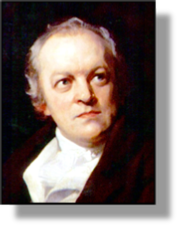 xxxxxThe English eccentric poet and illustrator William Blake, one of the greatest figures of the Romantic Movement, was a remarkable visionary who illustrated his own poetic works with strange hand-coloured engravings of immense visual impact and symbolic meaning. Such was the originality of his thought and artistic expression that in much of his creative work he stands alone, divorced from reality.
xxxxxThe English eccentric poet and illustrator William Blake, one of the greatest figures of the Romantic Movement, was a remarkable visionary who illustrated his own poetic works with strange hand-coloured engravings of immense visual impact and symbolic meaning. Such was the originality of his thought and artistic expression that in much of his creative work he stands alone, divorced from reality.
xxxxxHe was born in London and showed artistic talent from an early age. Strongly encouraged and supported by his father, a moderately successful hosier, he attended a drawing school at the age of ten, and then four years later became apprenticed to James Basire, a well known London engraver. Here he was sent out to work in numerous old churches, including Westminster Abbey, and from these visits he acquired a lasting love of Gothic sculpture and architecture. Here, too, he came to admire copies of works by the Italian renaissance painters Raphael and Michelangelo, and the German engraver Albrecht Durer, and these greatly influenced his subsequent style. In 1778 he began to study at the Royal Academy, but soon left, claiming that “copying nature” under the strict regime of the then president, Joshua Reynolds, deadened his imagination. It was then that he began working as an independent engraver and cam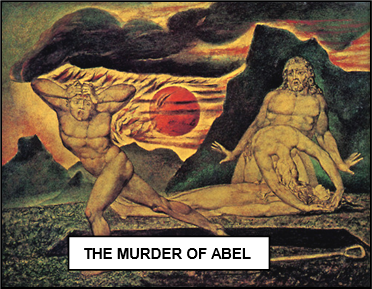 e to know the sculptor John Flaxman and the painter Henry Fuseli - both of whom came to admire his work. At first he began by illustrating the Bible, and the works of the famous, like those of William Shakespeare, but as his literary talent developed he began to use his outstanding skill as an engraver to illustrate his own poetical works.
e to know the sculptor John Flaxman and the painter Henry Fuseli - both of whom came to admire his work. At first he began by illustrating the Bible, and the works of the famous, like those of William Shakespeare, but as his literary talent developed he began to use his outstanding skill as an engraver to illustrate his own poetical works.
xxxxxHis first book of poems, Poetical Sketches, produced in 1783, met with little success - despite their lyrical quality - and was, in fact, his only work to be published by conventional means. In the following year he opened a small print shop next to his family home in Soho and, together with his younger brother Robert, began a series of experiments in the art of etching. Following the sudden death of Robert in 1787, he claimed that his brother returned to him in a vision, and showed him a unique method of printing both text and illustration by means of etched copper plates. Sceptics have since claimed that, in fact, he learned the process through a friend called George Cumberland, but, be that as it may, Blake appears to have possessed an intense, spiritual imagination from an early age. He was later to claim that his art work and poetry had been guided by angels, spirits of the dead, and his “daughters of inspiration”, who lived in the treetops. At one time he let it be known that he had seen fairies in his vegetable garden.
xxxxxThis new printing method called for an enormous amount of skill and patience and, when completed, each page had to be “illuminated” by water-colour, applied by pen or brush. Thus no two copies of the work were identical, and production was exceedingly slow. It is not surprising, therefore, that his work came to be admired by only a small circle of friends, and that much of his life was spent in poverty, eking out a living as an engraver and illustrator. For Blake this was of little consequence. He lived and worked in the spiritual not the material world, and found his inspiration from within the realm of his own highly-charged imagination. It is for this reason that his illustrations and paintings were full of strange imagery, and contained a personal symbolism which, in some cases, has defied interpretation.
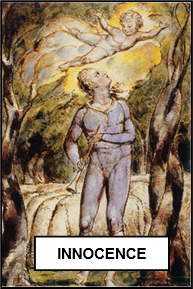
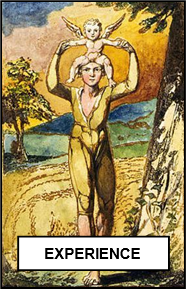 xxxxxHis earliest work of importance was his Songs of Innocence, produced in 1789, a book of eloquent poems noted for their childlike simplicity. This work was reprinted in 1794 together with its contrasting sequel, Songs of Experience, a collection which includes his famous poem Tyger - the incarnation of lust and cruelty. The “illuminated” pages in these two books are very reminiscent of medieval manuscripts - combining as they do words and images -, but the powerful, singular illustrations they contain are pure Blake, created not from observation, but from an inner, mystical vision. He then went on to produce a series of narrative poems, like the idyll, The Book of Thel, the satire The Marriage of Heaven and Hell, and The Visions of the Daughters of Albion, with its theme of sexual freedom. Then in 1797 he completed over 500 water colour drawings to illustrate Edward Young’s Night Thoughts, and provided illustrations and watercolour pictures to the poems of Thomas Gray.
xxxxxHis earliest work of importance was his Songs of Innocence, produced in 1789, a book of eloquent poems noted for their childlike simplicity. This work was reprinted in 1794 together with its contrasting sequel, Songs of Experience, a collection which includes his famous poem Tyger - the incarnation of lust and cruelty. The “illuminated” pages in these two books are very reminiscent of medieval manuscripts - combining as they do words and images -, but the powerful, singular illustrations they contain are pure Blake, created not from observation, but from an inner, mystical vision. He then went on to produce a series of narrative poems, like the idyll, The Book of Thel, the satire The Marriage of Heaven and Hell, and The Visions of the Daughters of Albion, with its theme of sexual freedom. Then in 1797 he completed over 500 water colour drawings to illustrate Edward Young’s Night Thoughts, and provided illustrations and watercolour pictures to the poems of Thomas Gray.
xxxxxAlongside these narratives went what came to be known as his Prophetic Books. These were longer works, some of which depicted the clash of giant powers, and contained epic battles between the forces of reason and imagination, fought out in history or within the human soul. Full of bizarre illustrations and elaborate imagery, and with a mythology all of their own, their symbolism has sometimes proved too personal to fathom. Included amongst these were America, the Prophecy, Europe, The Book of Urizen, The Book of Ahania, and the Book of Son O Los.
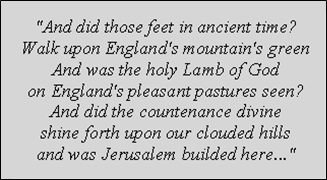
xxxxxAnd to this period belong Milton and his moving poem Jerusalem. Blake had witnessed with alarm the Gordon Riots of 1780, and openly applauded the aims of the French Revolution nine years later. Jerusalem, composed around 1820, is generally interpreted as a passionate plea for a movement away from the horrors of the Industrial Revolution - with its dark, satanic mills - and a political transition towards a tranquil age based on liberty, equality and fraternity. A rebel with many causes, Blake met regularly with a group of radicals at the home of the publisher and printer Joseph Johnson. Among this small gathering of freethinkers was the philosopher William Godwin, the feminist writer Mary Woolstonecraft, and Thomas Paine, the political pundit whom, so we are told, Blake saved from imprisonment by warning him that the authorities were coming to arrest him.
xxxxxBlake lived almost his entire life in London, but in the opening years of the 19th century he and his wife did spend what he called his “three years of slumber” at Felpham on the Sussex coast. But his happy days there were brought to an abrupt end in 1803 after a fracas with a soldier sent to cut the grass in his garden. He was then accused of making a treasonable remark - thought to be “Damn the king” - and although he was acquitted of the charge, he was obliged to leave Felpham and return to London. This incident featured in some of his later poems.
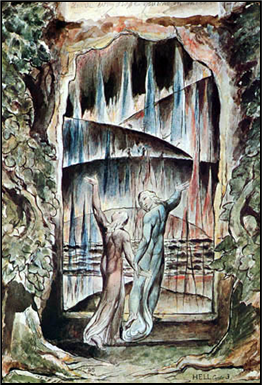 xxxxxAs from the early 1800s Blake concentrated on his illustrative work, and this included his masterpiece, The Body of Abel Found by Adam and Eve. Based on the murder of Abel, it is a highly emotional work, full of torment and anguish, enhanced by a vivid colour scheme (illustrated above). And to this period belongs watercolour designs for the Book of Job, (considered by many as his finest work), John Milton’s Paradise Lost and, famous above all, Dante’s Divine Comedy. By 1825 over one hundred drawings had been completed and hand-painted for Dante’s masterpiece, but he only had time to make engravings for seven of them. These exquisite, delicate paintings proved a final and fitting tribute to an artist of extraordinary talent and unique style. The illustration here shows Dante and the Roman poet Virgil about to pass through the gates of Hell. Blake died in 1827 and was buried in an unmarked grave in Bunhill Fields, North London. In 1957 a memorial to him and his wife was erected in Poets’ Corner in Westminster Abbey.
xxxxxAs from the early 1800s Blake concentrated on his illustrative work, and this included his masterpiece, The Body of Abel Found by Adam and Eve. Based on the murder of Abel, it is a highly emotional work, full of torment and anguish, enhanced by a vivid colour scheme (illustrated above). And to this period belongs watercolour designs for the Book of Job, (considered by many as his finest work), John Milton’s Paradise Lost and, famous above all, Dante’s Divine Comedy. By 1825 over one hundred drawings had been completed and hand-painted for Dante’s masterpiece, but he only had time to make engravings for seven of them. These exquisite, delicate paintings proved a final and fitting tribute to an artist of extraordinary talent and unique style. The illustration here shows Dante and the Roman poet Virgil about to pass through the gates of Hell. Blake died in 1827 and was buried in an unmarked grave in Bunhill Fields, North London. In 1957 a memorial to him and his wife was erected in Poets’ Corner in Westminster Abbey.
Acknowledgements
Blake: by the English portrait painter Thomas Philipps (1770-1845), 1807 – National Portrait Gallery, London. Blake Artwork: The Murder of Abel – Tate Gallery, London; Frontispiece – Songs of Innocence; Frontispiece – Songs of Experience; Dante and Virgil at the Gates of Hell – Tate Gallery, London; Nebuchadnezzar – Tate Gallery, London; Jacob’s Ladder – British Museum, London; Pity – Tate Gallery, London. Parry – portrait from a cigarette card (Wills’s Cigarettes) issued in 1914, artist unknown. Radcliffe: date and artist unknown. Lewis: by the English portrait painter Henry William Pickersgill (1782-1875), 1809 – National Portrait Gallery, London.
G3b-1783-1802-G3b-1783-1802-G3b-1783-1802-G3b-1783-1802-G3b-1783-1802-G3b

xxxxxIn his work, and particularly in his prophetic books, Blake mounted a bitter attack upon the hypocrisy, injustice and cruelty of his day. He opposed, too, atheism and the materialistic nature of society, pleading for the delights of the mind, and the liberation of the human spirit. Although his work was not well known in his own lifetime - indeed he was regarded as mad by some of his contemporaries, including the poet Robert Southey, - his long term influence has been substantial. He was of interest to the Pre-Raphaelite painters of the 19th century (particularly Dante Gabriel Rossetti), and he inspired, among others, the Irish poets W.B. Yeats and James Joyce, and the English novelist and poet D.H. Lawrence. Many of his works were lost after his death, but those that have survived have come to be numbered amongst the world’s greatest art treasures.
xxxxxBlake married Catherine Boucher in 1782, the illiterate daughter of a Battersea market gardener. Despite the hardships of their married life, she proved a devoted wife, and helped him with many of his projects, particularly with his illustrated poetry. Blake’s last drawing was of his beloved “Kate” but, 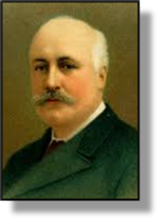 sadly, it was subsequently lost.
sadly, it was subsequently lost.
xxxxxIncidentally, Blake's poem Jerusalem, which appeared in his work Milton, was set to music by the brilliant English composer Hubert Parry (1848-1918) in 1916 and, during and after the First World War, virtually became a second national anthem. Parry did much to revive English music at the end of the 19th century, and among his compositions were five symphonies, three oratorios, anthems and service-settings, and a large number of songs. His works established him as the leading choral composer of his day. He wrote Studies of Great Composers in 1886, and The Evolution of the Art of Music ten years later. He was appointed Director of the Royal College of Music in 1895, and ended his career as professor of music at Oxford University. He was knighted in 1898 and made a baronet in 1902. He died in 1918 and was buried in St. Paul’s Cathedral.
xxxxxIt was in 1794, the year Blake published his Songs of Experience, that the English novelist Ann Radcliffe (1764-1823) gained fame with her “romance of terror”, The Mysteries of Udolpho. Reminiscent of the Castle of Otranto, the Gothic novel produced earlier by the English writer Horace Walpole, its frightening tale, set in a gloomy castle high up in the mountains of Italy, proved extremely popular. This was followed in 1797 by The Italian, a tale of terror centred around the exploits of a sinister monk named Schedoni. Among those who admired her work were Samuel Taylor Coleridge, Lord Byron, Sir Walter Scott and Christina Rossetti.
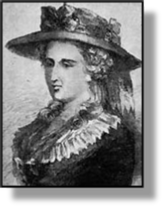 xxxxxIt was in 1794, the year Blake published his Songs of Experience, that the English novelist Ann Radcliffe (1764-1823) came to prominence with her Mysteries of Udolpho. This “romance of terror” - reminiscent of the Castle of Otranto, the Gothic novel produced 30 years earlier by the English writer Horace Walpole - caught the public’s imagination, and made her the most popular novelist in England.
xxxxxIt was in 1794, the year Blake published his Songs of Experience, that the English novelist Ann Radcliffe (1764-1823) came to prominence with her Mysteries of Udolpho. This “romance of terror” - reminiscent of the Castle of Otranto, the Gothic novel produced 30 years earlier by the English writer Horace Walpole - caught the public’s imagination, and made her the most popular novelist in England.
xxxxxShe was born into a well-to-do London family, and at the age of 23 married a journalist by the name of William Radcliffe. He encouraged her literary ambitions, but her first two novels, The Castles of Athlin and Dunbayne and A Sicilian Romance, were published anonymously. It was her next work, The Romance of the Forest, set in 17th century France, which brought her fame. Published under her name in 1791, it prepared the way for her remarkable success three years later.
xxxxxThe Mysteries of Udolpho had all the ingredients required of horror fiction, set as it was in a bleak, gloomy castle high up in the Apennine Mountains in Italy. Here the heroine, the orphaned Emily, is subjected to a series of weird and frightening events until, escaping from the clutches of her cruel guardians, she is united with her lover. As a novel, there was little or no attempt at characterisation, and the story itself was flawed and far-fetched, but it was skilfully instilled with an atmosphere of terror 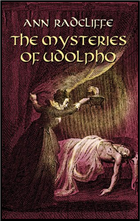
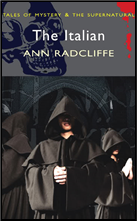 and an evil and eerie suspense, and it was this that thrilled and frightened the delighted reader. And she was, too, one of the first novelists to describe at length both landscape and weather, introduced in her particular case to heighten dramatic effect. Her subsequent “romance of terror”, The Italian, was produced in 1797. Centred around the exploits of the sinister Schedoni, a monk of giant proportions, it showed a marked improvement in both plot and dialogue, and revealed a greater understanding in the formation of its characters.
and an evil and eerie suspense, and it was this that thrilled and frightened the delighted reader. And she was, too, one of the first novelists to describe at length both landscape and weather, introduced in her particular case to heighten dramatic effect. Her subsequent “romance of terror”, The Italian, was produced in 1797. Centred around the exploits of the sinister Schedoni, a monk of giant proportions, it showed a marked improvement in both plot and dialogue, and revealed a greater understanding in the formation of its characters.
xxxxxDespite some shortcomings, her works were much admired by a number of leading literary figures, including Samuel Taylor Coleridge, Lord Byron and Christina Rossetti. Sir Walter Scott described her as “the first poetess of romantic fiction”. Despite her lurid tales, she led a quiet life. She never visited Italy, the back drop to much of her writing, but she did go to Holland and Germany on one occasion, and then described her travels in A Journey Made in the Summer of 1794.
xxxxxThe English novelist Matthew Gregory Lewis (1775-1818) was much taken with Ann Radcliffe’s The Mysteries of Udolpho, and two years later produced his own Gothic tale of horror, The Monk. So successful was it, that from then on he was known as “Monk” Lewis. Its popularity might well have rested as much upon its eroticism as upon its horror sequences and passages of violence.
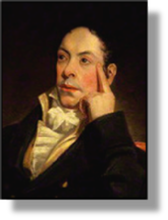 xxxxxThe English novelist and dramatist Matthew Gregory Lewis (1775-1818) was much taken with Ann Radcliffe’s The Mysteries of Udolpho, and two years later produced his own Gothic tale of horror, The Monk. So successful was it that for ever after he was known as “Monk” Lewis. Its popularity probably rested as much upon its eroticism as upon its horror sequences and passages of violence. It was followed by his play The Castle Spectre, a musical drama in the same vein, produced by the dramatist Richard Brinsley Sheridan in 1798.
xxxxxThe English novelist and dramatist Matthew Gregory Lewis (1775-1818) was much taken with Ann Radcliffe’s The Mysteries of Udolpho, and two years later produced his own Gothic tale of horror, The Monk. So successful was it that for ever after he was known as “Monk” Lewis. Its popularity probably rested as much upon its eroticism as upon its horror sequences and passages of violence. It was followed by his play The Castle Spectre, a musical drama in the same vein, produced by the dramatist Richard Brinsley Sheridan in 1798.
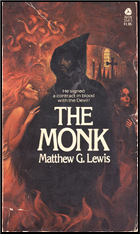
xxxxxUnlike Radcliffe, Lewis led an active life. After studying at Christ Church, Oxford, he served in the diplomatic service, and became a member of parliament in 1796. In 1812 he inherited some large estates in Jamaica, and made two journeys out there to improve the conditions of his 500 slaves. During his second visit he contracted yellow fever and died in 1818, but his Journal of a West India Proprietor, published in 1834, testified to his genuine concern for the welfare of the slave labour on his estates.







 xxxxxThe English eccentric poet and illustrator William Blake, one of the greatest figures of the Romantic Movement, was a remarkable visionary who illustrated his own poetic works with strange hand-
xxxxxThe English eccentric poet and illustrator William Blake, one of the greatest figures of the Romantic Movement, was a remarkable visionary who illustrated his own poetic works with strange hand- e to know the sculptor John Flaxman and the painter Henry Fuseli -
e to know the sculptor John Flaxman and the painter Henry Fuseli -
 xxxxxHis earliest work of importance was his Songs of Innocence, produced in 1789, a book of eloquent poems noted for their childlike simplicity. This work was reprinted in 1794 together with its contrasting sequel, Songs of Experience, a collection which includes his famous poem Tyger -
xxxxxHis earliest work of importance was his Songs of Innocence, produced in 1789, a book of eloquent poems noted for their childlike simplicity. This work was reprinted in 1794 together with its contrasting sequel, Songs of Experience, a collection which includes his famous poem Tyger -
 xxxxxAs from the early 1800s Blake concentrated on his illustrative work, and this included his masterpiece, The Body of Abel Found by Adam and Eve. Based on the murder of Abel, it is a highly emotional work, full of torment and anguish, enhanced by a vivid colour scheme (illustrated above). And to this period belongs watercolour designs for the Book of Job, (considered by many as his finest work), John Milton’s Paradise Lost and, famous above all, Dante’s Divine Comedy. By 1825 over one hundred drawings had been completed and hand-
xxxxxAs from the early 1800s Blake concentrated on his illustrative work, and this included his masterpiece, The Body of Abel Found by Adam and Eve. Based on the murder of Abel, it is a highly emotional work, full of torment and anguish, enhanced by a vivid colour scheme (illustrated above). And to this period belongs watercolour designs for the Book of Job, (considered by many as his finest work), John Milton’s Paradise Lost and, famous above all, Dante’s Divine Comedy. By 1825 over one hundred drawings had been completed and hand-
 sadly, it was subsequently lost.
sadly, it was subsequently lost.  xxxxxIt was in 1794, the year Blake published his Songs of Experience, that the English novelist Ann Radcliffe (1764-
xxxxxIt was in 1794, the year Blake published his Songs of Experience, that the English novelist Ann Radcliffe (1764-
 and an evil and eerie suspense, and it was this that thrilled and frightened the delighted reader. And she was, too, one of the first novelists to describe at length both landscape and weather, introduced in her particular case to heighten dramatic effect. Her subsequent “romance of terror”, The Italian, was produced in 1797. Centred around the exploits of the sinister Schedoni, a monk of giant proportions, it showed a marked improvement in both plot and dialogue, and revealed a greater understanding in the formation of its characters.
and an evil and eerie suspense, and it was this that thrilled and frightened the delighted reader. And she was, too, one of the first novelists to describe at length both landscape and weather, introduced in her particular case to heighten dramatic effect. Her subsequent “romance of terror”, The Italian, was produced in 1797. Centred around the exploits of the sinister Schedoni, a monk of giant proportions, it showed a marked improvement in both plot and dialogue, and revealed a greater understanding in the formation of its characters.  xxxxxThe English novelist and dramatist Matthew Gregory Lewis (1775-
xxxxxThe English novelist and dramatist Matthew Gregory Lewis (1775-


